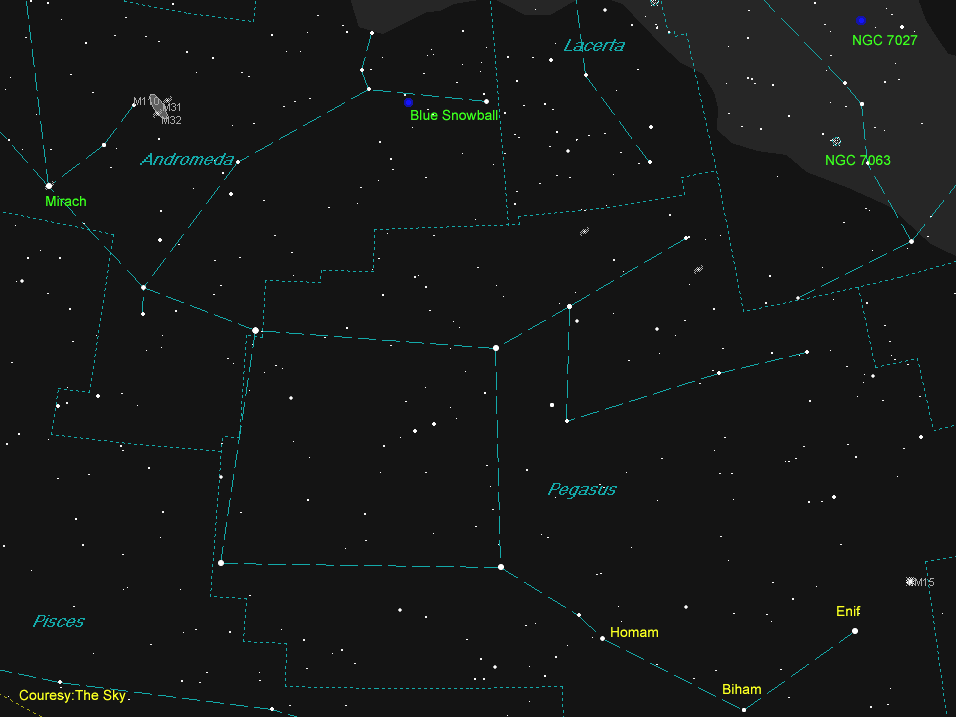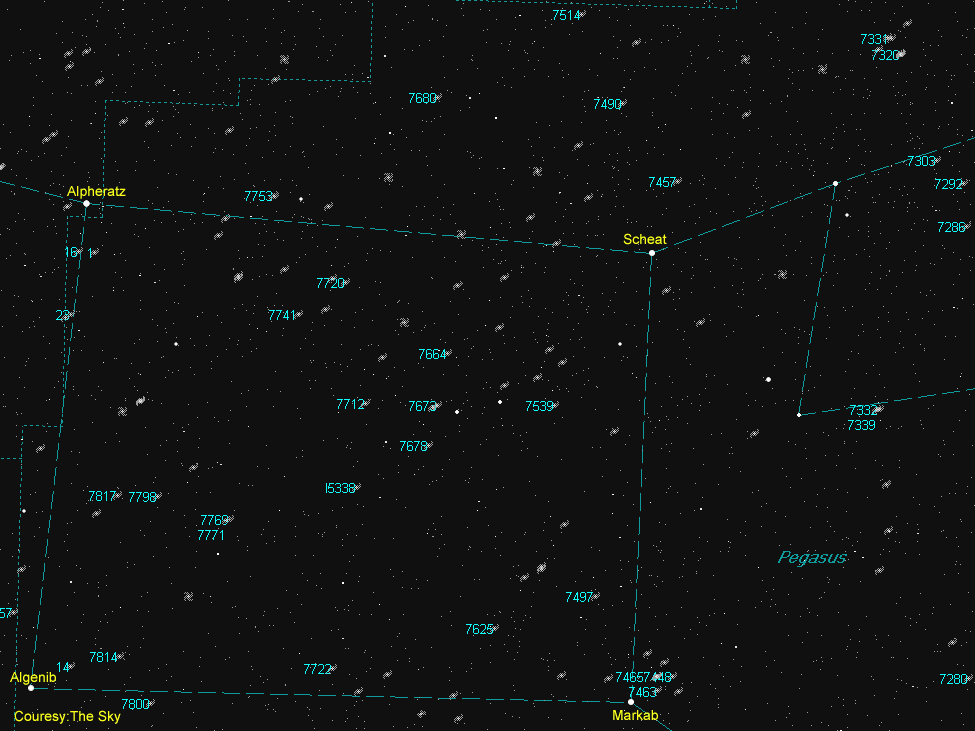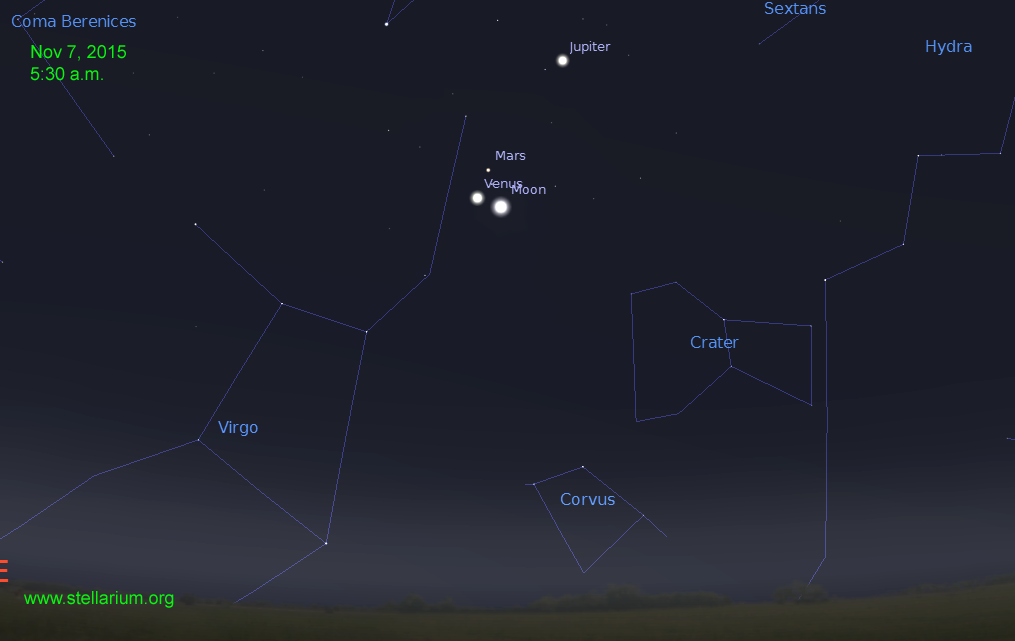The Great Square
On these cool November nights, the Great Square of Pegasus reins high overhead. It crosses the meridian at 9 p.m. local time at the beginning of the month and 7 p.m. by month’s end. With a total of 1,121 square degrees of sky, Pegasus ranks 7th in overall size. In mythology, Pegasus played a part in the story entitled “The Royal Family of Constellation”. The story goes on to describe Perseus the Hunter coming to the rescue of Andromeda (daughter of King Cepheus and Queen Cassiopeia) who was sacrificed and about to be devoured by the sea monster Cetus. Upon slaying the beast, Perseus and Andromeda rode off on the winged horse Pegasus. The large square consists of four bright stars ranging from magnitude 2.5 to 2.8 and outlines the main portion of the animal’s body. In fact, Pegasus is oriented upside down with its long neck to the lower right ending at the star Enif. Derived from the Arabic meaning nose, Enif is an orange K2 supergiant star at a distance of 670 light-years. Its surface is a bit cooler than the Sun generating a temperature of 4,460 Kelvin compared to the Sun’s 5,778 Kelvin. If this supergiant sun resided in our solar system, it would measure half the distance to the planet, Venus.

Move to the upper left star of the square named Alpheratz. Although you would assume this is designated to Pegasus, the star is now officially named Alpha Andromedae but was co-named Delta Pegasi in the 17th century by Johann Bayer. Located 97 light-years from us, magnitude 2.1 Alpheratz has a very close companion about a tenth the brightness of the principal star. The spectrum of light indicated the pair orbits a common centre of gravity every 96.7 days. This B9 star has a surface temperature more than twice that of the Sun and is 200 times brighter when we take its ultraviolet radiation into account. On the top right of the Square, we have the star Scheat at 196 light-years distance. It shines at magnitude 2.4 and is classified as an M2 subgiant red star. It is still growing to eventually reach giant status. This star is currently 1,500 times brighter than our Sun.
51 Pegasi has a very special place in the history books. At 50.9 light-years from us, 51 Pegasi is one and a quarter times the diameter of our Sun and about 8.6 billion years old. It is the first Sun-like star to have a planet orbiting it. 51b was first discovered on October 6, 1995, and has been named Bellerophon. With a radius 1.2 times that of Jupiter, Bellerophon’s orbit is extremely close to its parent star. In fact, at the distance of only .05 AU, it takes the planet a mere 4.2 days to orbit. 51 Pegasi is listed at magnitude 5.4 and is located between Scheat and Markab.
Pegasus has a good selection of galaxies to hunt and photograph, for example, NGC 7771. Here we see a magnitude 12.1 barred spiral galaxy at a distance of 160 million light-years. It measures 2.4 by 1.1 arc minutes. In the same field of view, there is NGC 7770 situated just below and NGC 7769 only 4 arc minutes to the west. NGC 7771 can be found in the lower-left quadrant of the Square.

A larger and brighter target is NGC 7741. Here is an eleventh magnitude face-on barred spiral galaxy with dimensions measuring 4.5 by 2.9 arc minutes and has a magnitude 9.8 star seemingly attached to it. It first glance it appears to be a supernova at the edge of this 47 million light-years distant galaxy. The star in question is catalogued SAO 91455. One of the most observed and photographed galaxies in Pegasus is NGC 7331. This lovely spiral is located 48 million light-years away, measuring 145,000 light-years in length and is referred to as our Milky Way twin. The most peculiar fact about this galaxy is its core rotates in the opposite direction with respect to the arms spin. The four remote galaxies together with NGC 7331 are known as the Deer Lick Group.
From here we now move to the faint gathering of very distant galaxies called Stephan’s Quintet. This tight group of six galaxies is found about 30 arc minutes or the width of the full moon in the seven o’clock position from the Deer Lick Group. Stephan's Quintet is composed of six galaxies: NGC 7317, NGC 7318A, NGC 7318B, NGC 7319, NGC 7320 and NGC 7320C. The first four are true members that reside 270 million light-years away. NGC 7320 is a foreground galaxy that happens to lie in the same line of sight and is only 40 million light-years distant. However, NGC 7320C is an estimated 460,000 further back from the original four.
We cannot leave the area without visiting the Andromeda Galaxy. From dark sites, one can spot the closest major galaxy with the naked eye. More than twice the length of our Milky Way, the Andromeda Galaxy spans 260,000 light-years compared to our 100,000 light-years. It has an estimated one trillion stars and is accompanied by fourteen dwarf galaxies including its two satellite galaxies catalogued as M32 and M110. Our two galaxies are on a collision course but will occur some 4 billion years from now. By then, our Sun will have almost exhausted its internal fuel supply and become a red giant.
Andromeda has a wealth of detail from the before mentioned satellite galaxies to the NGC 206, a star cloud situated at the edge near M32 and detectable in moderate size telescopes. The galaxy is so close, astronomers have identified hundreds of globular clusters and other objects. To hunt these down, large telescopes or photography is required. Use charts 1 and 2 to track them down.
The morning sky still reveals Venus, Jupiter and Mars in all their glory. During the last week of October, we woke up each mooring to a slightly different pattern in the east. Even the general public has been commenting on these portraits. The next conjunction will take place on November 3 when Venus will be .7 degrees south or Mars. Then on November 7, the 15% waning crescent moon will be only two degrees southwest of Venus and another opportunity to drag out the camera. The annual Leonid meteor shower will peak on the morning of November 18 with only 20 meteors per hour. The good news is no moon to interfere.

A spectacular occultation of magnitude 0.8 Aldebaran by the moon will occur on the morning of November 26. The moon will begin to cover the star at 5:38 a.m. EDT and will be seen across Canada. The star will reappear fifty minutes later on the moon’s right limb. This month’s New Moon (lunation 1149) occurs on November 11 and the Full Hunter’s or Beaver Moon lights up the night on November 25th. And finally, if the time change applies to you on November 1, remember to properly convert to Universal Time from your time zone.
Until next month, clear skies everyone.
Twitter: @astroeducator
